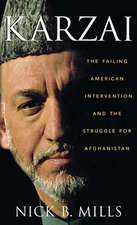October Fury
Autor Peter A. Huchthausenen Limba Engleză Paperback – 18 dec 2003
–– TOM CLANCY
Drama on the high seas as the world holds its breath
It was the most spectacular display of brinkmanship in the Cold War era. In October 1962, President Kennedy risked inciting a nuclear war to prevent the Soviet Union from establishing missile bases in Cuba. The risk, however, was far greater than Kennedy realized.
October Fury uncovers startling new information about the Cuban missile crisis and the potentially calamitous confrontation between U.S. Navy destroyers and Soviet submarines in the Atlantic. Peter Huchthausen, who served as a junior ensign aboard one of the destroyers, reveals that a single shot fired by any U.S. warship could have led to an immediate nuclear response from the Soviet submarines.
This riveting account re–creates those desperate days of confrontation from both the American and Russian points of view and discloses detailed information about Soviet operational plans and the secret orders given to submarine commanders. It provides an engrossing, behind–the–scenes look at the technical and tactical functions of two great navies along with stunning portraits of the officers and sailors on both sides who were determined to do their duty even in the most extreme circumstances.
As absorbing and detailed as a Tom Clancy novel, this real–life suspense thriller is destined to become a classic of naval literature.
| Toate formatele și edițiile | Preț | Express |
|---|---|---|
| Paperback (1) | 93.39 lei 3-5 săpt. | |
| Wiley – 18 dec 2003 | 93.39 lei 3-5 săpt. | |
| Hardback (1) | 215.75 lei 3-5 săpt. | |
| Wiley (TP) – 12 sep 2002 | 215.75 lei 3-5 săpt. |
Preț: 93.39 lei
Nou
Puncte Express: 140
Preț estimativ în valută:
17.87€ • 18.46$ • 14.87£
17.87€ • 18.46$ • 14.87£
Carte disponibilă
Livrare economică 04-18 martie
Preluare comenzi: 021 569.72.76
Specificații
ISBN-13: 9780471468844
ISBN-10: 0471468843
Pagini: 281
Dimensiuni: 146 x 227 x 20 mm
Greutate: 0.39 kg
Editura: Wiley
Locul publicării:Hoboken, United States
ISBN-10: 0471468843
Pagini: 281
Dimensiuni: 146 x 227 x 20 mm
Greutate: 0.39 kg
Editura: Wiley
Locul publicării:Hoboken, United States
Public țintă
Naval history and submarine fans; readers of Tom Clancy novels and Blind Man′s Bluff; public libraries; naval historical sites, especially submarine sites, like Submarine Force Museum at New London, CT.Descriere
It was the most spectacular display of brinkmanship in the Cold War era. In October 1962, President Kennedy risked inciting a nuclear war to prevent the Soviet Union from establishing missile bases in Cuba. The risk, however, was far greater than Kennedy realized. October Fury uncovers startling information about the Cuban missile crisis and the potentially calamitous confrontation between U.S. Navy destroyers and Soviet submarines in the Atlantic. Peter Huchthausen, who served as a junior ensign aboard one of the destroyers, reveals that a single shot fired by any U.S. warship could have led to an immediate nuclear response from the Soviet submarines. As absorbing and detailed as a Tom Clancy novel, this real–life suspense thriller is destined to become a classic of naval literature.
Textul de pe ultima copertă
It was the most spectacular display of brinkmanship in the Cold War era. In October 1962, President Kennedy risked inciting a nuclear war to prevent the Soviet Union from establishing missile bases in Cuba. The risk, however, was far greater than Kennedy realized. October Fury uncovers startling information about the Cuban missile crisis and the potentially calamitous confrontation between U.S. Navy destroyers and Soviet submarines in the Atlantic. Peter Huchthausen, who served as a junior ensign aboard one of the destroyers, reveals that a single shot fired by any U.S. warship could have led to an immediate nuclear response from the Soviet submarines. As absorbing and detailed as a Tom Clancy novel, this real–life suspense thriller is destined to become a classic of naval literature.
Cuprins
Preface. Prologue.
Part I. Cuba Libre.
Operation Anadyr.
Destroyer USS Blandy.
The Art of Antisubmarine Warfare.
Operation Kama Departure.
October Fury.
Part II. Spies and Diplomats.
Part III. Russian Roulette.
Atlantic Datum.
Carrier Randolph Finds Savitsky′s B–59.
Cecil vs. Dubivko in B–36.
Blandy vs. Shumkov in B–130.
Part IV. Hide–and–Seek.
Soviet Shell Game.
Ketov Evades in B–4.
Part V. Endgame.
Kola Homecoming.
Newport Farewell.
Notes.
Bibliography.
Index.
Part I. Cuba Libre.
Operation Anadyr.
Destroyer USS Blandy.
The Art of Antisubmarine Warfare.
Operation Kama Departure.
October Fury.
Part II. Spies and Diplomats.
Part III. Russian Roulette.
Atlantic Datum.
Carrier Randolph Finds Savitsky′s B–59.
Cecil vs. Dubivko in B–36.
Blandy vs. Shumkov in B–130.
Part IV. Hide–and–Seek.
Soviet Shell Game.
Ketov Evades in B–4.
Part V. Endgame.
Kola Homecoming.
Newport Farewell.
Notes.
Bibliography.
Index.
Notă biografică
Captain Peter A. Huchthausen, U.S. Navy (Retired) has had a distinguished career at sea, as a Soviet naval analyst, and as a naval attache in Yugoslavia, Romania, and in the Soviet Union. He is now a consultant and writer. He lives in Maine.
Recenzii
In the fall of 1962, Huchthausen (Hostile Waters) was a junior navy officer on the USS Blandy, a Forrest Sherman class destroyer; he and his fellow crew members were center stage during the Cuban missile crisis as they confronted Soviet submarines and merchant ships off the coast of Cuba. The submarines were equipped with nuclear–tipped torpedoes and had been given secret orders to use those new and virtually untested weapons if American forces attacked them or if American submarine–hunting destroyers forced them to surface. That set of circumstances came very close to leading to an exchange of tactical nuclear weapons–an event that likely would have sparked nuclear war between the United States and the Soviet Union. Huchthausen details the story of what happened in those waters in this riveting account, based on his own experience and extensive interviews he conducted with former Soviet submariners and his former shipmates. Through reconstructed dialogue (and plenty of naval technospeak), he reveals that nuclear war was averted primarily by the heroic actions of three of the players in the high seas drama: Comdr. Edward G. Kelley, the Blandy′s quixotic but experienced commanding officer; Capt. Nikolai Shumkov, who courageously and conscientiously commanded one of the four Soviet subs in Cuban waters; and Rear Adm. Leonid F. Rybalko, another veteran naval officer who, from his base in Moscow, countermanded dangerous orders from his superiors and paved the way for a peaceful denouement of the tense confrontation at sea. Nicely balanced between operational and analytical material, this account should satisfy action–seeking lay readers and buffs. (Oct.) (Publishers Weekly, September 9, 2002) Most accounts of the Cuban Missile Crisis (October 18–31, 1962), from Robert Kennedy′s Thirteen Days to Robert Weisbrot′s Maximum Danger and The Presidential Recordings: John F. Kennedy: The Great Crises, recount the harrowing diplomatic parrying betwetn President Kennedy and Soviet Premier Khrushchev to avoid nuclear war. Huchthausen (HostileWaters) tells the lesser–known but no less frightening story of the Soviet and U.S. sailors sent to Cuba to be the nuclear tripwire. The author was a young ensign aboard the USS Blandy, assigned to stop Soviet ships from delivering weapons to Cuba and to make sure that the missiles were ultimately removed. Much of the book is about Operation Anadyr, the Soviet deployment of missiles and troops to Cuba. Riveting details include the hazards of Soviet submarine travel–which entailed dangerous storms, lack of food and fresh water, loss of oxygen, and inescapable diesel fumes–and how nuclear war was narrowly avoided by the quick thinking of U.S. and Soviet captains. Unlike the Americans, the Soviet officers had prior authorization to launch nuclear–tipped missiles from their submarines. The book is tinged with humorous anecdotes, and Huchthausen succeeds admirably in portraying sympathetically the sailors who would have been the first to die if war had been declared. This book will appeal to history buffs and to fans of espionage fiction.
Highly recommended for public libraries. Karl Helicher, Upper Merion Twp. Lib.; King of Prussia, PA (Library Journa, September 15, 2002)
In October 1962, the Cold War became about as hot as it would get, as the United States and the Soviet Union came to the brink of nuclear war.
The spark was the Cuban missile crisis, which is at the core of Peter A. Huchthausen′s excellent book, "October Fury."
Huchthausen was a participant. He was a junior officer aboard the destroyer USS Blandy, which had been part of the U.S. Navy blockade of Cuba and had pursued one of four Soviet submarines sent to the region.
His recollections, told 40 years later, clearly and engagingly, reflect the young officer′s confidence and enthusiasm and even glee during his adventure.
Trouble began when the Soviets attempted to establish an aggressive beachhead in Fidel Castro′s communist Cuba, right at America′s doorstep.
It would consist of a naval base, a contingent of troops and weapons, an air force of medium–range bombers and launch sites for nuclear–tipped ballistic missiles.
Since the United States had a military advantage over the Soviet Union, the success of the plan hinged on secrecy. The Soviets had to keep their military presence in Cuba unknown until it was so well–established that Moscow could present Washington and the world with an irreversible "fait accompli."
However, the heavy traffic of ships between Soviet ports and Cuba was impossible to conceal. On Oct. 22, the U.S. Navy began a blockade to prevent Soviet ships from entering Cuban ports and to engage and destroy, if necessary, any that resisted.
The blockade fleet consisted largely of aircraft carriers and destroyers. Planes from the carriers located and identified the Soviet–bloc ships and directed the destroyers to them. The destroyers challenged the ships and instructed them to go back.
The four Soviet subs ordered to set up their base at Mariel, Cuba, were detected by sonar. The destroyers locked on to them and tracked them relentlessly, trying to force them to surface by exhausting their supplies of air and electric battery power. Although one sub did evade its pursuer, the three others had to surface in the presence of the tracking destroyers.
One of the subs had come close to firing a nuclear torpedo at an American destroyer that had accidentally aimed a gun turret at it. But the destroyer′s skipper promptly ordered the gun moved and in turn the sub′s captain canceled his firing preparations.
The crisis cooled as the Soviets backed down, realizing that America would go to war if pushed too far. The missile sites were dismantled and the weapons and troops were returned to Russia.
Huchthausen later became friendly with retired Soviet Naval Capt. Lev Vtorygin, who, during the crisis, was Russia′s naval attaché in Washington. Vtorygin located surviving crew members of the subs and obtained their insights, which Huchthausen has worked smoothly into his book by alternating American and Russian episodes.
The Cuban missile crisis was a milestone in the Cold War and the saga of the sailors on both sides, as told in this remarkable book, is a colorful and exciting part of the overall picture. (AP Weekly Features, October 28, 2002)
"Huchthausen details the story of what happened in those waters in this riveting account.... Nicely balanced between operational and analytical material..." (Publishers Weekly, September 9, 2002) "Huchthausen succeeds admirably in portraying sympathetically the sailors who would have been the first to die if war had been declared.... The book is tinged with humorous anecdotes, and Huchthausen succeeds admirably..." (Library Journal, September 15, 2002)
"excellent...remarkable." (AP Weekly Features, October 28, 2002)
Highly recommended for public libraries. Karl Helicher, Upper Merion Twp. Lib.; King of Prussia, PA (Library Journa, September 15, 2002)
In October 1962, the Cold War became about as hot as it would get, as the United States and the Soviet Union came to the brink of nuclear war.
The spark was the Cuban missile crisis, which is at the core of Peter A. Huchthausen′s excellent book, "October Fury."
Huchthausen was a participant. He was a junior officer aboard the destroyer USS Blandy, which had been part of the U.S. Navy blockade of Cuba and had pursued one of four Soviet submarines sent to the region.
His recollections, told 40 years later, clearly and engagingly, reflect the young officer′s confidence and enthusiasm and even glee during his adventure.
Trouble began when the Soviets attempted to establish an aggressive beachhead in Fidel Castro′s communist Cuba, right at America′s doorstep.
It would consist of a naval base, a contingent of troops and weapons, an air force of medium–range bombers and launch sites for nuclear–tipped ballistic missiles.
Since the United States had a military advantage over the Soviet Union, the success of the plan hinged on secrecy. The Soviets had to keep their military presence in Cuba unknown until it was so well–established that Moscow could present Washington and the world with an irreversible "fait accompli."
However, the heavy traffic of ships between Soviet ports and Cuba was impossible to conceal. On Oct. 22, the U.S. Navy began a blockade to prevent Soviet ships from entering Cuban ports and to engage and destroy, if necessary, any that resisted.
The blockade fleet consisted largely of aircraft carriers and destroyers. Planes from the carriers located and identified the Soviet–bloc ships and directed the destroyers to them. The destroyers challenged the ships and instructed them to go back.
The four Soviet subs ordered to set up their base at Mariel, Cuba, were detected by sonar. The destroyers locked on to them and tracked them relentlessly, trying to force them to surface by exhausting their supplies of air and electric battery power. Although one sub did evade its pursuer, the three others had to surface in the presence of the tracking destroyers.
One of the subs had come close to firing a nuclear torpedo at an American destroyer that had accidentally aimed a gun turret at it. But the destroyer′s skipper promptly ordered the gun moved and in turn the sub′s captain canceled his firing preparations.
The crisis cooled as the Soviets backed down, realizing that America would go to war if pushed too far. The missile sites were dismantled and the weapons and troops were returned to Russia.
Huchthausen later became friendly with retired Soviet Naval Capt. Lev Vtorygin, who, during the crisis, was Russia′s naval attaché in Washington. Vtorygin located surviving crew members of the subs and obtained their insights, which Huchthausen has worked smoothly into his book by alternating American and Russian episodes.
The Cuban missile crisis was a milestone in the Cold War and the saga of the sailors on both sides, as told in this remarkable book, is a colorful and exciting part of the overall picture. (AP Weekly Features, October 28, 2002)
"Huchthausen details the story of what happened in those waters in this riveting account.... Nicely balanced between operational and analytical material..." (Publishers Weekly, September 9, 2002) "Huchthausen succeeds admirably in portraying sympathetically the sailors who would have been the first to die if war had been declared.... The book is tinged with humorous anecdotes, and Huchthausen succeeds admirably..." (Library Journal, September 15, 2002)
"excellent...remarkable." (AP Weekly Features, October 28, 2002)










